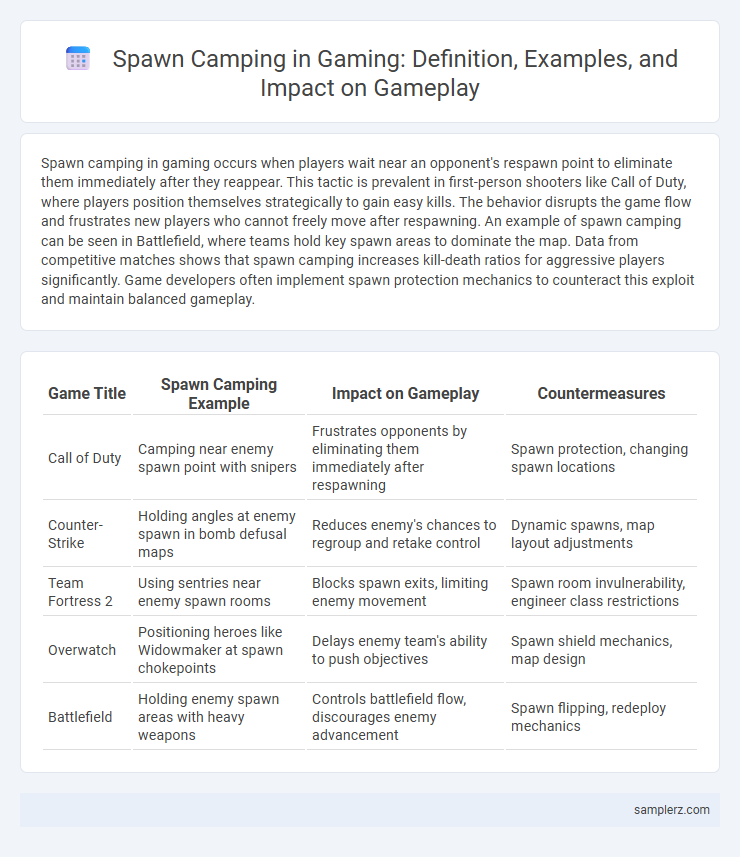Spawn camping in gaming occurs when players wait near an opponent's respawn point to eliminate them immediately after they reappear. This tactic is prevalent in first-person shooters like Call of Duty, where players position themselves strategically to gain easy kills. The behavior disrupts the game flow and frustrates new players who cannot freely move after respawning. An example of spawn camping can be seen in Battlefield, where teams hold key spawn areas to dominate the map. Data from competitive matches shows that spawn camping increases kill-death ratios for aggressive players significantly. Game developers often implement spawn protection mechanics to counteract this exploit and maintain balanced gameplay.
Table of Comparison
| Game Title | Spawn Camping Example | Impact on Gameplay | Countermeasures |
|---|---|---|---|
| Call of Duty | Camping near enemy spawn point with snipers | Frustrates opponents by eliminating them immediately after respawning | Spawn protection, changing spawn locations |
| Counter-Strike | Holding angles at enemy spawn in bomb defusal maps | Reduces enemy's chances to regroup and retake control | Dynamic spawns, map layout adjustments |
| Team Fortress 2 | Using sentries near enemy spawn rooms | Blocks spawn exits, limiting enemy movement | Spawn room invulnerability, engineer class restrictions |
| Overwatch | Positioning heroes like Widowmaker at spawn chokepoints | Delays enemy team's ability to push objectives | Spawn shield mechanics, map design |
| Battlefield | Holding enemy spawn areas with heavy weapons | Controls battlefield flow, discourages enemy advancement | Spawn flipping, redeploy mechanics |
Definition and Overview of Spawn Camping
Spawn camping is a gaming tactic where players position themselves near the enemy's respawn point to repeatedly eliminate opponents as they re-enter the game. This strategy often disrupts gameplay balance and frustrates players by denying them a fair chance to react after respawning. Common in first-person shooters like Call of Duty and Counter-Strike, spawn camping exploits map design to gain a tactical advantage.
Classic Examples of Spawn Camping in FPS Games
Classic examples of spawn camping in FPS games include titles like Counter-Strike, where players often hold vantage points near the enemy's spawn to gain an unfair advantage. In Call of Duty series, spawn camping is frequently seen in multiplayer modes, with players exploiting spawn locations to repeatedly eliminate opponents upon respawning. This tactic disrupts game balance and frustrates players by limiting their ability to regroup and counterattack effectively.
Spawn Camping in Team-Based Shooters
Spawn camping in team-based shooters occurs when players position themselves near the enemy's respawn points to eliminate opponents immediately upon their return, disrupting game balance. Popular titles like Call of Duty and Overwatch see frequent spawn camping, which forces developers to implement spawn protection or dynamic spawn points to maintain fair gameplay. Effective counter-strategies include team communication, controlling map areas away from spawns, and coordinated pushes to prevent opponents from dominating critical respawn zones.
Notorious Spawn Camping Maps in Gaming History
Notorious spawn camping maps like Dust II in Counter-Strike and Nuketown in Call of Duty have become infamous for their high spawn trap potential, frequently frustrating players with relentless ambushes immediately after respawning. These maps feature tightly clustered spawn points and limited escape routes, enabling aggressive players to dominate early engagements. The persistent presence of spawn camping in these iconic maps has sparked extensive debate about map design and fair gameplay within the gaming community.
How Spawn Camping Impacts Competitive Play
Spawn camping disrupts the balance of competitive play by constantly targeting opponents immediately after they respawn, denying them a fair chance to engage. This tactic leads to frustration, decreased morale, and often forces teams to adopt overly defensive strategies, reducing overall gameplay depth. Persistent spawn camping can undermine skill-based competition by emphasizing positional dominance over strategic maneuvering.
Developer Responses to Spawn Camping
Developer responses to spawn camping in gaming often include implementing spawn protection, where players are temporarily invulnerable upon respawning to prevent immediate kills. Some developers redesign map layouts to provide safer spawn zones, reducing enemy line of sight and choke points. Regular updates and patches also address exploitative spawn spots, aiming to balance gameplay fairness and enhance player experience.
Ethical Debates Around Spawn Camping
Spawn camping in gaming involves players waiting near an opponent's respawn point to gain an unfair advantage, often provoking heated ethical debates within the community. Critics argue that it disrupts fair play and diminishes the skill-based aspects of competitive gaming, while proponents claim it's a tactical element inherent to strategic gameplay. Discussions frequently revolve around balancing game design mechanics and player behavior to ensure both challenge and fairness.
Spawn Camping in Casual vs. Ranked Matches
Spawn camping in casual matches often results in quick respawns and minimal frustration, as players usually prioritize fun over competition. In ranked matches, spawn camping significantly impacts gameplay by disrupting team strategies and increasing player tension, leading to stricter community reporting and potential penalties. Effective map control and communication are essential to prevent spawn camping from undermining competitive integrity.
Community Reactions to Spawn Camping Incidents
Spawn camping in popular games like Call of Duty and Fortnite often incites strong community backlash, with players criticizing such tactics for ruining fair gameplay. Forums and social media platforms frequently feature heated debates where users demand stricter penalties against those who exploit spawn points to gain easy kills. Developers sometimes respond by implementing spawn protection mechanics to balance gameplay and address player concerns.
Preventative Strategies Against Spawn Camping
Preventative strategies against spawn camping in gaming often include implementing spawn protection zones that grant temporary invulnerability to players upon respawn, ensuring they can safely re-enter the match without immediate threat. Designing maps with multiple spawn points and randomizing spawns minimizes predictability, reducing the likelihood of players being trapped in spawn areas. Incorporating dynamic environmental elements, such as teleporters or escape routes near spawn zones, further aids players in evading spawn campers and maintaining fair gameplay balance.

example of spawn camping in gaming Infographic
 samplerz.com
samplerz.com